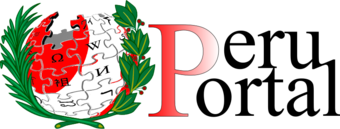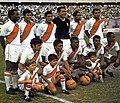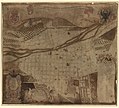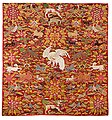Portal:Peru
Introduction
Peru, officially the Republic of Peru, is a country in western South America. It is bordered in the north by Ecuador and Colombia, in the east by Brazil, in the southeast by Bolivia, in the south by Chile, and in the south and west by the Pacific Ocean. Peru is a megadiverse country with habitats ranging from the arid plains of the Pacific coastal region in the west to the peaks of the Andes mountains extending from the north to the southeast of the country to the tropical Amazon basin rainforest in the east with the Amazon River. Peru has a population of over 32 million, and its capital and largest city is Lima. At 1,285,216 km2 (496,225 sq mi), Peru is the 19th largest country in the world, and the third largest in South America. Peruvian territory was home to several cultures during the ancient and medieval periods, and has one of the longest histories of civilization of any country, tracing its heritage back to the 10th millennium BCE. Notable pre-colonial cultures and civilizations include the Caral–Supe civilization (the earliest civilization in the Americas and considered one of the cradles of civilization), the Nazca culture, the Wari and Tiwanaku empires, the Kingdom of Cusco, and the Inca Empire, the largest known state in the pre-Columbian Americas. The Spanish Empire conquered the region in the 16th century and Charles V established a viceroyalty with the official name of the Kingdom of Peru that encompassed most of its South American territories, with its capital in Lima. Higher education started in the Americas with the official establishment of the National University of San Marcos in Lima in 1551. Peru's population includes Mestizos, Amerindians, Europeans, Africans and Asians. The main spoken language is Spanish, although a significant number of Peruvians speak Quechuan languages, Aymara, or other Indigenous languages. This mixture of cultural traditions has resulted in a wide diversity of expressions in fields such as art, cuisine, literature, and music. (Full article...) Entries here consist of Good and Featured articles, which meet a core set of high editorial standards.
A pisco sour is an alcoholic cocktail of Peruvian origin that is traditional to both Peruvian and Chilean cuisine. The drink's name comes from pisco, a brandy which is its base liquor, and the cocktail term sour, implying sour citrus juice and sweetener components. The Peruvian pisco sour uses Peruvian pisco and adds freshly squeezed lime juice, simple syrup, ice, egg white, and Angostura bitters. The Chilean version is similar, but uses Chilean pisco and Pica lime, and excludes the bitters and egg white. Other variants of the cocktail include those created with fruits like pineapple or plants such as coca leaves. Although the preparation of pisco-based mixed beverages possibly dates back to the 1700s, historians and drink experts agree that the cocktail as it is known today was invented in the early 1920s in Lima, the capital of Peru, by the American bartender Victor Vaughen Morris. Morris left the United States in 1903 to work in Cerro de Pasco, a city in central Peru. In 1916, he opened Morris' Bar in Lima, and his saloon quickly became a popular spot for the Peruvian upper class and English-speaking foreigners. The oldest known mentions of the pisco sour are found in newspaper and magazine advertisements, dating to the early 1920s, for Morris and his bar published in Peru and Chile. The pisco sour underwent several changes until Mario Bruiget, a Peruvian bartender working at Morris' Bar, created the modern Peruvian recipe for the cocktail in the latter part of the 1920s by adding Angostura bitters and egg whites to the mix. (Full article...)Selected image Photo credit: Ericbronder
The main square of Abancay, capital of the Apurímac Region, has several palm trees which have adapted to the city's elevation of 2378 meters above sea level. Most cities in Peru have main squares, which are called Plaza de Armas in Spanish. They are usually surrounded by the principal city buildings such as the town hall or the main church. (more...) Selected battleThe Battle of Angamos (8 October 1879) was an important struggle in the War of the Pacific, where the Peruvian ironclad Huáscar was surrounded and captured by the Chilean Navy. The captain of the ironclad, Peruvian Admiral Miguel Grau, was killed in the combat. After this battle, the Peruvian Navy was unable to prevent the invasion of its territorial sea. The seas were cleared for the invasion of Peru and Bolivia. (more...) In this month
General imagesThe following are images from various Peru-related articles on Wikipedia.
Selected article -Trujillo (Spanish: [tɾuˈxiʝo]; Quechua: Truhillu; Mochica: Cɥimor) is a city in coastal northwestern Peru and the capital of the Department of La Libertad. It is the third most populous city and center of the third most populous metropolitan area of Peru. It is located on the banks of the Moche River, near its mouth at the Pacific Ocean, in the Moche Valley. This was a site of the great prehistoric Moche and Chimu cultures before the Inca conquest and subsequent expansion. The Independence of Trujillo from Spain was proclaimed in the Historic Centre of Trujillo on December 29, 1820, and the city was honored in 1822 by the Congress of the Republic of Peru with the title "Meritorious City and Faithful to the Fatherland", for its role in the fight for Peruvian independence. Trujillo is the birthplace of Peru's judiciary, and it was twice designated as the capital of the country. It was the scene of the Revolution of Trujillo in 1932. Trujillo is considered the "cradle of liberty and cradle of the judiciary in Peru". (Full article...)Did you know (auto-generated) -
CategoriesRelated portalsSelected quote -
1st Protector of Peru José de San Martín 1778–1850
Basic facts & figuresMore did you know...
Peru TopicsRecognized content
Featured articlesFeatured listsGood articles
WikiProjectsThings you can do
New articlesThis list was generated from these rules. Questions and feedback are always welcome! The search is being run daily with the most recent ~14 days of results. Note: Some articles may not be relevant to this project.
Rules | Match log | Results page (for watching) | Last updated: 2024-06-05 21:39 (UTC) Note: The list display can now be customized by each user. See List display personalization for details.
Associated WikimediaThe following Wikimedia Foundation sister projects provide more on this subject:
Discover Wikipedia using portals | |||||||||||||||




















































